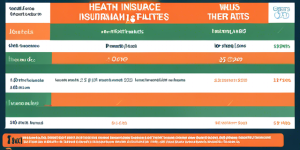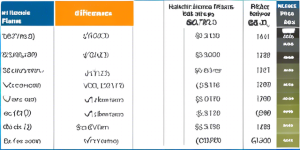Navigating the Maze of Health Insurance Rates 2024

When it comes to health insurance, finding the right coverage at an affordable rate can feel like a daunting task. With countless options available and a myriad of factors to consider, it’s easy to get lost in the maze of health insurance rates. However, arming yourself with the right knowledge and strategies can help you navigate this complex landscape and ensure you’re getting the best value for your money.
Understanding Health Insurance Rates
Before we dive into the intricacies of comparing health insurance rates, it’s essential to understand what factors influence these rates. Health insurance premiums are determined by a variety of elements, including:
1. Age and Health Status
Insurers consider your age and overall health condition when calculating premiums. Generally, older individuals and those with pre-existing medical conditions can expect to pay higher rates.
2. Location
The cost of living and healthcare expenses in your area play a significant role in determining your health insurance rates. Rates can vary widely between different states and even within the same city.
3. Plan Type and Coverage Level
The type of health insurance plan you choose (e.g., HMO, PPO, or POS) and the level of coverage (e.g., bronze, silver, gold, or platinum) will significantly impact your premiums. More comprehensive plans with lower out-of-pocket costs typically come with higher monthly premiums.
4. Tobacco Use
Insurers often charge higher premiums for individuals who use tobacco products, as they are at a higher risk for various health complications.
5. Family Size
The number of individuals covered under your health insurance plan can also affect your rates. Larger families generally pay higher premiums than individuals or couples.
Comparing Health Insurance Rates: A Step-by-Step Guide

Now that you understand the factors influencing health insurance rates, let’s dive into the process of comparing and finding the best deal for your needs.
Step 1: Determine Your Coverage Needs
Before you start shopping for health insurance, take some time to assess your healthcare needs. Consider your age, lifestyle, and any pre-existing medical conditions you or your family members may have. This will help you determine the level of coverage you require and narrow down your options.
Step 2: Explore Your Options
There are several avenues to explore when it comes to health insurance options:
Employer-Sponsored Plans
If you’re employed, check with your employer to see if they offer group health insurance plans. These plans can often be more affordable than individual plans due to the risk-sharing among a larger pool of participants.
Individual Marketplace Plans
If you don’t have access to an employer-sponsored plan or if you’re self-employed, you can purchase an individual health insurance plan through your state’s health insurance marketplace or directly from private insurers. These plans are typically more expensive than group plans, but they offer a wide range of coverage options.
Government-Sponsored Programs
Depending on your income level and other factors, you may qualify for government-sponsored programs like Medicaid or the Children’s Health Insurance Program (CHIP). These programs can provide comprehensive coverage at little or no cost.
Step 3: Gather Quotes
Once you’ve identified your options, it’s time to start gathering quotes from different insurers. Many insurance companies offer online tools or have dedicated representatives who can provide you with customized quotes based on your specific needs and location.
When comparing quotes, pay close attention to the following:
- Monthly premiums
- Deductibles
- Out-of-pocket maximums
- Co-payments and coinsurance rates
- Network coverage (if the plan is an HMO or PPO)
- Prescription drug coverage
- Additional benefits (e.g., vision, dental, or mental health coverage)
Don’t just focus on the premium alone; consider the overall cost of the plan, including potential out-of-pocket expenses.
Step 4: Leverage Online Comparison Tools
To streamline the process of comparing health insurance rates, consider using online comparison tools. These tools allow you to input your information and preferences, and then provide you with a list of available plans and their corresponding rates.
Some popular online comparison tools include:
- HealthCare.gov (for plans offered through the federal marketplace)
- eHealthInsurance
- GoHealthInsurance
- HealthSherpa
These tools can save you time and effort by consolidating information from various insurers in one place, making it easier to compare and contrast different options.
Step 5: Consider Additional Factors
While cost is a significant factor when comparing health insurance rates, it’s essential to consider other factors as well:
Network Coverage
If you have preferred healthcare providers, ensure they are included in the plan’s network. Going out-of-network can result in higher out-of-pocket costs.
Prescription Drug Coverage
If you or a family member takes regular medications, check the plan’s formulary (list of covered drugs) and associated costs.
Customer Service and Reputation
Research the insurer’s customer service ratings and overall reputation. You want to choose a company that is responsive and has a track record of handling claims efficiently.
Future Needs
Consider your future healthcare needs as well. If you’re planning to start a family or anticipate a significant life change, ensure the plan you choose can accommodate those needs.
Strategies for Saving on Health Insurance

While finding affordable health insurance can be challenging, there are several strategies you can employ to save money on your premiums:
1. Shop Around and Negotiate
Don’t settle for the first quote you receive. Shop around and negotiate with insurers to see if they can offer you a better rate. Insurers may be willing to provide discounts or lower rates to secure your business.
2. Consider High-Deductible Health Plans (HDHPs)
HDHPs typically have lower monthly premiums but higher deductibles. If you’re generally healthy and don’t anticipate significant medical expenses, an HDHP combined with a Health Savings Account (HSA) can be a cost-effective option.
3. Explore Subsidies and Tax Credits
Depending on your income level and household size, you may qualify for subsidies or tax credits that can reduce your health insurance costs. These are typically available through your state’s health insurance marketplace or the federal marketplace.
4. Maintain a Healthy Lifestyle
Insurers often offer discounts or lower rates for individuals who maintain a healthy lifestyle. Quitting smoking, exercising regularly, and maintaining a healthy weight can not only improve your overall well-being but also potentially lower your health insurance rates.
5. Consider Group Plans
If you’re self-employed or don’t have access to an employer-sponsored plan, explore options for joining professional or trade associations that offer group health insurance plans. These plans can be more affordable than individual plans due to risk-sharing among a larger pool of participants.
Conclusion
Navigating the maze of health insurance rates can be a daunting task, but with the right knowledge and strategies, you can find a plan that fits your needs and budget. Remember to assess your coverage requirements, explore all available options, and leverage online comparison tools to streamline the process. Don’t hesitate to negotiate with insurers and explore strategies for saving money on your premiums. By taking a proactive approach, you can ensure you and your family have access to quality healthcare without breaking the bank.
FAQs
1. How often should I compare health insurance rates? It’s generally recommended to compare health insurance rates annually during the open enrollment period. However, if you experience a significant life event (e.g., marriage, birth, job change), you may need to reevaluate your coverage and rates more frequently.
2. Can I change health insurance plans mid-year? In most cases, you can only change health insurance plans during the annual open enrollment period or if you experience a qualifying life event (e.g., job loss, marriage, or relocation). However, some plans may allow you to make changes at certain times throughout the year.
3. What happens if I don’t have health insurance? In most states, there is no longer a tax penalty for not having health insurance. However, going without coverage can be risky, as you’ll be responsible for paying the full cost of any medical expenses out-of-pocket.
4. Can I get health insurance if I have a pre-existing condition? Yes, under the Affordable Care Act (ACA), insurers cannot deny coverage or charge higher premiums based solely on pre-existing conditions. However, the specifics of your coverage and rates may vary depending on your condition and the plan you choose.

